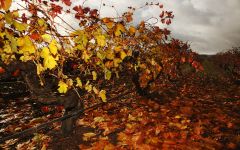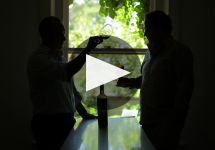Elderton Ode To Lorraine 2013
-
Robert
Parker -
Wine
Spectator



Product Details
Your Rating
Somm Note
Winemaker Notes
Professional Ratings
-
Robert Parker's Wine Advocate
With a deep garnet-purple color, the 2013 Csm Ode To Lorraine reveals cassis, black plums and charred earth notes with hints of cedar, dark chocolate, lavender and dried herbs. Medium to full-bodied and packed with muscular fruit on the palate, it has a firm backbone of grainy tannins and a lively acid line carrying the fruit to a long, multilayered finish. Rating: 93(+) Points.
-
Wine Spectator
Opens with pure plum flavors before revealing shades of spice and black licorice, with toasted herb notes. Juicy up front, the tannins gain some grip on the finish. Cabernet Sauvignon, Shiraz and Merlot. Drink now through 2026.
Other Vintages
2015-
Australian Wine
Companion -
James
Suckling -
Wine
Spectator
-
James
Suckling -
Wine
Spectator -
Robert
Parker
-
Robert
Parker -
Wine
Spectator -
Wilfred
Wong
-
Robert
Parker
-
Wine
Spectator
-
Wine
Spectator






After time spent working in Saudi Arabia, Neil and Lorraine Ashmead, moved to the Barossa in 1979, after Lorraine’s father identified a beautiful home with potential. The Ashmeads believed this would be a great place to raise their family. The homestead, in the heart of the township of Nuriootpa, was surrounded by extremely old Shiraz and Cabernet Sauvignon vines. At a time where demand for Australian table wine was negligible, the vineyard had become derelict. After years of no interest, the real estate agent eventually offered the Ashmeads the 72 acre vineyard as a bonus, as part of the sale of the homestead. Three years later, after restoring the vineyard, Elderton Wines was born.
The second generation, Cameron and Allister, took the reins of the business in 2003 and today work together to run Elderton Wines, with Lorraine still involved through her role on the Board. Cameron and Allister believe very strongly in continuing the traditions that began a generation earlier, on the Nuriootpa vineyard. Wanting to take the family company to the next level, they together devised a plan to buy great vineyards in other significant sub appellations of the Barossa. Through using sustainable practices, the hope is that the next generation of the Ashmead family have a lot to work with when they are at the helm.

With hundreds of red grape varieties to choose from, winemakers have the freedom to create a virtually endless assortment of blended red wines. In many European regions, strict laws are in place determining the set of varieties that may be used, but in the New World, experimentation is permitted and encouraged resulting in a wide variety of red wine styles. Blending can be utilized to enhance balance or create complexity, lending different layers of flavors and aromas. For example, a red wine blend variety that creates a fruity and full-bodied wine would do well combined with one that is naturally high in acidity and tannins. Sometimes small amounts of a particular variety are added to boost color or aromatics. Blending can take place before or after fermentation, with the latter, more popular option giving more control to the winemaker over the final qualities of the wine.
How to Serve Red Wine
A common piece of advice is to serve red wine at “room temperature,” but this suggestion is imprecise. After all, room temperature in January is likely to be quite different than in August, even considering the possible effect of central heating and air conditioning systems. The proper temperature to aim for is 55° F to 60° F for lighter-bodied reds and 60° F to 65° F for fuller-bodied wines.
How Long Does Red Wine Last?
Once opened and re-corked, a bottle stored in a cool, dark environment (like your fridge) will stay fresh and nicely drinkable for a day or two. There are products available that can extend that period by a couple of days. As for unopened bottles, optimal storage means keeping them on their sides in a moderately humid environment at about 57° F. Red wines stored in this manner will stay good – and possibly improve – for anywhere from one year to multiple decades. Assessing how long to hold on to a bottle is a complicated science. If you are planning long-term storage of your reds, seek the advice of a wine professional.

Historically and presently the most important wine-producing region of Australia, the Barossa Valley is set in the Barossa zone of South Australia, where more than half of the country’s wine is made. Because the climate is very hot and dry, vineyard managers work diligently to ensure grapes reach the perfect levels of phenolic ripeness.
The intense heat is ideal for plush, bold reds, particularly Shiraz on its own or Rhône Blends. Often Shiraz and Cabernet partner up for plump and powerful reds.
While much less prevalent, light-skinned varieties such as Riesling, Viognier or Semillon produce vibrant Barossa Valley whites.
Most of Australia’s largest wine producers are based here and Shiraz plantings date back as far as the 1850s or before. Many of them are dry farmed and bush trained, still offering less than one ton per acre of inky, intense, purple juice.
